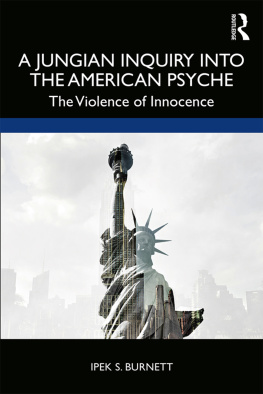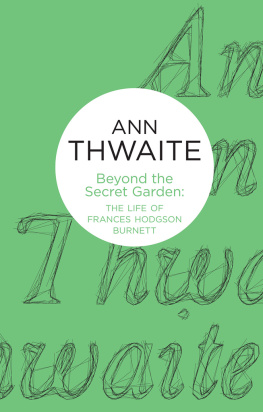Charles Burnett
The publisher and the University of California Press
Foundation gratefully acknowledge the generous support of the
Robert and Meryl Selig Endowment Fund in Film Studies,
established in memory of Robert W. Selig.
Charles Burnett

A CINEMA OF SYMBOLIC KNOWLEDGE
James Naremore

UNIVERSITY OF CALIFORNIA PRESS
University of California Press, one of the most distinguished university
presses in the United States, enriches lives around the world by advancing
scholarship in the humanities, social sciences, and natural sciences. Its
activities are supported by the UC Press Foundation and by philanthropic
contributions from individuals and institutions. For more information, visit
www.ucpress.edu.
University of California Press
Oakland, California
2017 by The Regents of the University of California
Library of Congress Cataloging-in-Publication Data
Names: Naremore, James, author.
Title: Charles Burnett : a cinema of symbolic knowledge / James Naremore.
Description: Oakland, California : University of California Press, [2017] |
Includes bibliographical references and index. |
Identifiers: LCCN 2017016678 (print) | LCCN 2017019353 (ebook) |
ISBN 9780520960954 (ebook) | ISBN 9780520285538 (pbk. : alk. paper) |
ISBN 9780520285521 (cloth : alk. paper)
Subjects: LCSH : Burnett, Charles, 1944Criticism and interpretation. |
African American motion picture producers and directorsUnited States.
Classification: LCC PN 1998.3. B 865 (ebook) | LCC PN 1998.3. B 865 N 37 2017
(print) | DDC 791.4302/33092dc23
LC record available at https://lccn.loc.gov/2017016678
Manufactured in the United States of America
26 25 24 23 22 21 20 19 18 17
10 9 8 7 6 5 4 3 2 1
For Darlene Sadlier, who helped in more ways than I can
count; for Jay Naremore (who writes novels under the name
Jim), Amy Rubin (memoirist and photographer), and
Alexander and Patrick Naremore (budding filmmakers); and
in memory of Phyllis Klotman.
CONTENTS
7 Three Films for Young Adults and Families:
Selma, Lord, Selma (1999), Finding Buck McHenry (2000),
and Nightjohn (1996)
13 Two Screenplays: Bless Their Little Hearts (1984) and
Man in a Basket (2003)
ACKNOWLEDGMENTS
My thanks to the Motion Picture Academy of Arts and Sciences, which awarded me a scholars grant in support of this book. Thanks also to Michael T. Martin, Brian Graney, and the staff of the Black Film Center Archive at Indiana University; to John Vickers and the staff of Indiana University Cinema; to Linda Harris Mehr, Matt Severson, and Elisabeth Cathcart of the Herrick Library in Los Angeles; and to Mark Quigley and the staff of the Research and Study Center at the UCLA Film and Television Archive. For individual help and advice, Im especially grateful to Edward Dimendberg and Robert E. Kapsis, who read and supported the manuscript. Thanks also to Janet Cutler, Julie Dash, Allyson Field, Jonathan Rosenbaum, and Craig Simpson. As usual, I could never have written the manuscript without the help of my wife, Darlene J. Sadlier, a talented scholar and writer who read each chapter, gave me invaluable suggestions for improving things, and was always there with love and moral support.
Mary Francis, a former editor at University of California Press, initially contracted the project. Her successor, Raina Polivka, has been a great gift to me; unfailingly patient, intelligent, and encouraging, Raina provided editorial support beyond the call of duty when it was most needed. Her editorial assistant, Zuha Khan, cheerfully guided me through the production process; Sharon Langworthy was a fine copy editor, and the designers at the press did their work skillfully.
Portions of the book, in different forms, appeared in Charles Burnett, a Troublesome Filmmaker, edited by Maria Miguez and Victor Paz (Cantabria, Spain: Play-Doc Books, 2016); the March 2017 issue of Black Camera: An International Journal, edited by Michael T. Martin; the Summer 2017 issue of Cineaste, edited by Gary Crowdus; and the September 2017 issue of The Ryder magazine, edited by Peter LoPilato. I am grateful to these publications for their help.
One of Charles Burnetts best producers, Carolyn Schroder, answered my e-mail questions and gave me permission to quote her; she also made it possible for me to talk with Burnett in Los Angeles. And Im especially thankful for the help of Charles Burnett himself. Ive never written about a filmmaker whom I have had the pleasure of meeting. In this case I tried to maintain a certain distance because I didnt want to distract him from his work or make my book seem authorized. We had only a couple of conversations, and he kindly answered the factual questions I asked him via e-mail. (In the text, whenever I mention things Burnett told me, Im referring to the e-mail remarks he gave me permission to use.) He also gave me a copy of his unproduced screenplay for Man in a Basket and a video of his seldom-seen The Final Insult. As anyone who knows him can probably tell you, hes a modest, generous man, always ready to give credit to others, whose considerable knowledge and strength of character are clothed in an unpretentious, gentle personality. Hes not responsible for any errors in this book. It was an honor to meet him, and I hope Ive done him justice.
ONE

A Cinema of Symbolic Knowledge
CHARLES BURNETT , WHOM CRITIC Jonathan Rosenbaum has described as the countrys most important African American film director, is relatively unknown outside the world of committed cinephiles. One of the many reasons he deserves greater attention is that virtually the whole of his remarkable career has been devoted to the proposition that Black Lives Matter. His feature pictures have dealt with poor black families struggling to survive in Los Angeles (Killer of Sheep [1977]), generational or social-class tensions that threaten to split black families apart (To Sleep with Anger [1990]), police murders and incarcerations of innocent black men (The Glass Shield [1994]), black attempts to achieve literacy under the nightmarish conditions of plantation-era slavery (Nightjohn [1996]), and the bloody Namibian war for independence from South Africa (Namibia: The Struggle for Liberation [2007]). His experimental documentaries and short films have concerned the Nat Turner rebellion (Nat Turner: A Troublesome Property [2003]), the poverty of a black single mother (When It Rains [1995]), urban homelessness (The Final Insult [1997]), and the displacement of blacks in the wake of Hurricane Katrina (Quiet as Kept [2007]). Even his lively, semidocumentary celebration of blues music (Warming by the Devils Fire [2003]) is filled with archival material showing that behind the music is a history of lynching and enforced labor of blacks in the American South. As I write hes at work on two documentaries, one about the 1960s civil rights movement to end segregated hospitals, and the other, in cooperation with the Watts Community Action Center, about chemical poisoning of water in South Central Los Angeles. He recently told Spanish interviewers that the stand your ground law and the wave of police shootings of unarmed blacks in the United States are reversions to pre-1960s terrorism directed against the black community. I live in fear every day, he told the interviewers. Every time my sons leave their house, I worry about them coming back (Miguez and Paz 2016, 6869).
Next page














